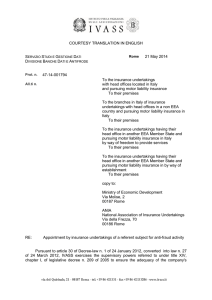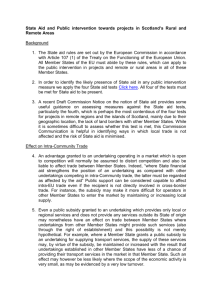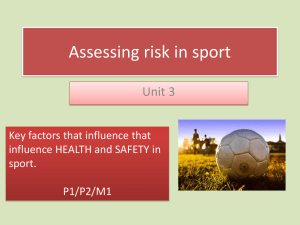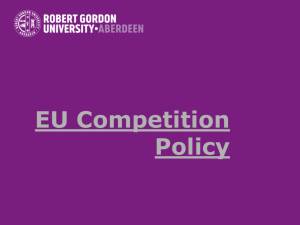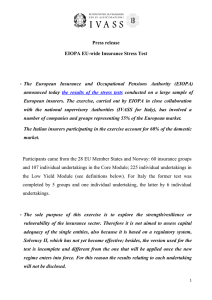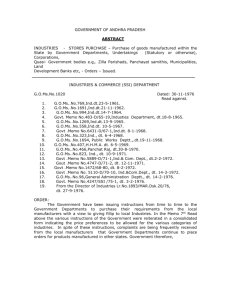SPORT AND COMPETITION LAW AT EU LEVEL
advertisement
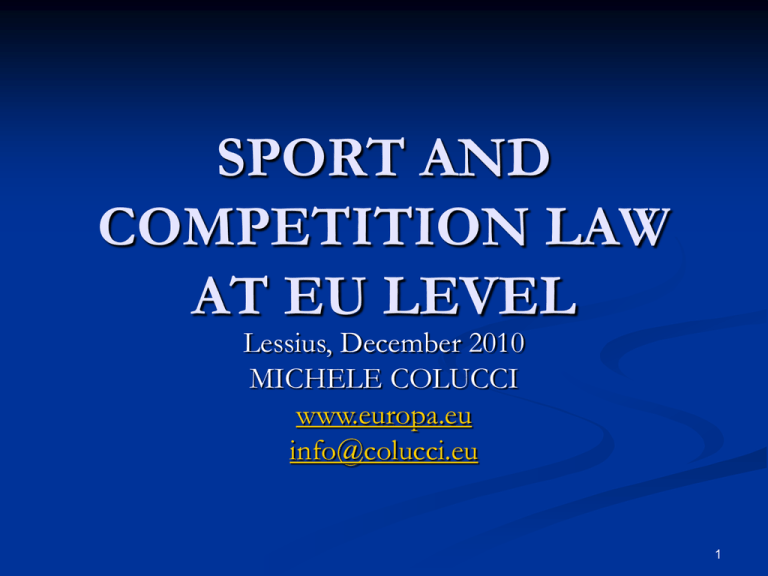
SPORT AND COMPETITION LAW AT EU LEVEL Lessius, December 2010 MICHELE COLUCCI www.europa.eu info@colucci.eu 1 The European Model of Sport The “Pyramid” model 2 Characteristics Promotion and relegation Grassroots approach (starting from the clubs) Stakeholders and their role (who does what) 3 EC TREATY ART. 81 EC: Are incompatible (and void )with the common market all agreements between undertakings, decisions by associations of undertakings and concerted practices which may: affect trade between Member States have as their object or effect the prevention, restriction or distortion of competition within the common market 4 Exceptions Agreements which contributes to improving: the production or distribution of goods or to promoting technical or economic progress, while allowing consumers a fair share of the resulting benefit, And which does not: (a) impose on the undertakings concerned restrictions which are not indispensable to the attainment of these objectives; (b) afford such undertakings the possibility of eliminating competition in respect of a substantial part of the products in questio 5 ABUSE OF DOMINANT POSITION ART. 82 EC: Any abuse by one or more undertakings of a dominant position within the common market or in a substantial part of it shall be prohibited as incompatible with the common market in so far as it may affect trade between Member States. 6 ABUSE OF DOMINANT POSITION Such abuse may, in particular, consist in: (a) directly or indirectly imposing unfair purchase or selling prices or other unfair trading conditions; (b) limiting production, markets or technical development to the prejudice of consumers; (c) applying dissimilar conditions to equivalent transactions with other trading parties, thereby placing them at a competitive disadvantage; (d) making the conclusion of contracts subject to acceptance by the other parties of supplementary obligations which, by their nature or according to commercial usage, have no connection with the subject of such contracts. 7 Fields of application in Sport Transfer rules Sale of tickets Broadcasting rights Monopoly of federations Multi-ownership of clubs 8 Basic Principles of Community Law EC law applies to Sport in so far it constitutes an economic activity (ECJ case law) No Activities “purely” social, artistic or sporting ...... but then “MECA MEDICA” judgement of 18 July 2006... Test of “Necessity” Test of “Proportionality” 9 Applicability of EC competition law to football Question:Are Sports federations (private entities) associations of undertakings? Undertaking under art. 81 is “every entity engages in an economic activity, regardless of the legal status of the entity and the way in which it is financed” Nature, profit, and aims are irrelevant! Sport industries: many services Analysis of finacial resources, training of players, ... 10 Nature of Transfer regulations Decision of an association of undertakings: Regulations issued by the executive committee of FIFA adopetd on the legal basis of the federation’s statutes No importance if they are legally binding or mere recommendations 11 THE RELEVANT MARKET GEOGRAPHICAL Market: territory of all associations PRODUCT MARKET: EXPLOITATION Market: where clubs and association exploit their performance CONTEST MARKET: where the performance are exploited (the Sporting contest) SUPPLY MARKET: where the clubs “sell” and buy” players 12 RESTRICTION OF COMPETITION AMOUNT OF TRANSFER PAYMENT EFFECT ON THE MARKET: Strong clubs remain strong Players less paid NECESSITY OF THE TRANSFER REGULATIONS: Maintaining financial and competitive balance Compensation for cost of training EFFECT ON TRADE BETWEEN MSs 13 THE ECJ CASE LAW analysis and perspective BOSMAN PIAU MECA MEDINA 14 THE MECA MEDINA CASE Compatibility of rules with the Community rules on competition cannot be assessed in the abstract. Taking into account: “the overall context” in which the decision of the association of undertakings was taken or produces its effects. Its objectives: measures inherent in the pursuit of those objectives and proportionate to them. 15 THE NEW SCENARIO RETHINKING SPORT AT EU LEVEL? NEW STRATEGIES AMONG STAKEHOLDERS? CO-OPERATION WITH THE EU INSTITUTIONS? CHANGE THE EU LEGISLATION IN THE NAME OF AUTONOMY AND SPECIFICITY OF SPORT? 16 CONCLUSIONS ALL ROADS LEAD TO ROME BUT FIRST ... THEY GO THROUGH BRUSSELS 17

